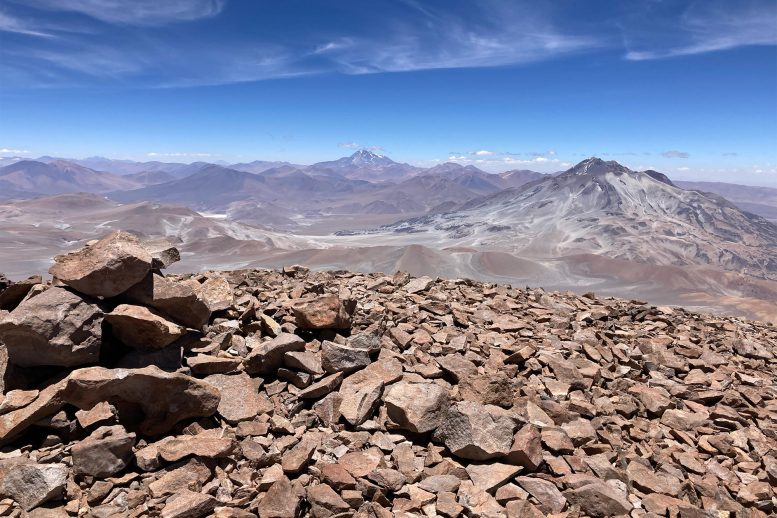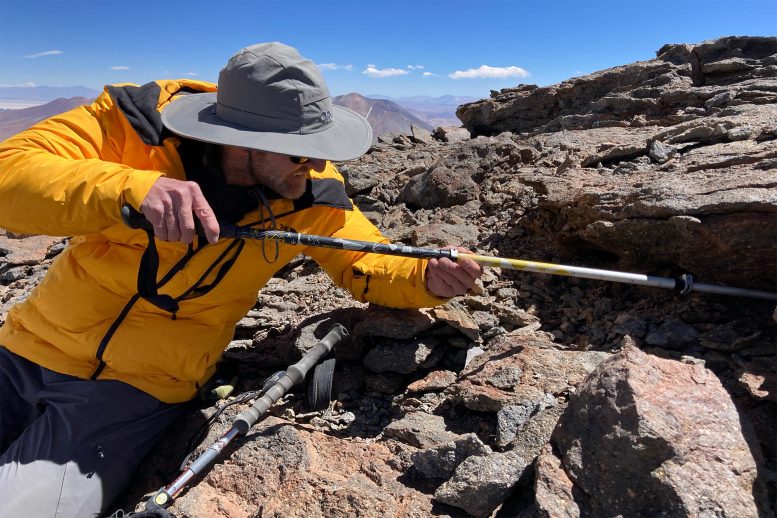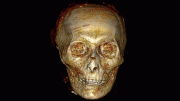
A view from the summit of Volcán Salín, one of three Andean volcanoes where researchers uncovered the mummified cadavers of mice. Analyses of the mummies, combined with the capture of live specimens, suggest that the rodents scaled the Mars-like peaks on their own — and are somehow managing to live on them. Credit: Jay Storz, University of Nebraska–Lincoln
The study dismisses any connection to Incan rituals, suggesting that mice ascended independently.
In the midst of the driest desert on Earth, atop 20,000-foot volcanoes, the environment was harsh and unforgiving. The temperatures remained perpetually below freezing, the oxygen levels were less than half of what is found at sea level, and the peaks were battered by gale-force winds that swept across the sparse, rocky terrain.
So when archaeologists first reported stumbling across a few mouse cadavers during expeditions to several Andean peaks in the 1970s and ’80s, they figured, naturally, that the rodents must have hitched a ride with the Incas who once pilgrimaged a thousand-plus miles to what they considered sacred sites.
Those apexes served as altars for Capacocha, the ritual sacrifice of children to several Incan gods. Maybe, the thinking went, the mice had scurried into firewood or other supplies hauled up the slopes by the Incas. Or they were among the animal sacrifices that sometimes accompanied the humans.
“You can’t fault the archaeologists for thinking this way, because what other explanation is there?” said Jay Storz, a Willa Cather Professor of biological sciences at the University of Nebraska–Lincoln. “Nothing could be living up there, so they had to have been brought there.”
A New Hypothesis Emerges
But Storz would inadvertently cast doubt on the hypothesis in early 2020. Alongside friend and fellow mountaineer Mario Pérez Mamani, he captured a live specimen of leaf-eared mouse atop the 22,000-foot peak of Llullaillaco (zhoo-zhuh-ZHEYE’-koh), a volcano straddling the Chile-Argentina border. No mammal had ever been found living at such extreme altitude.
Alongside the capture of more live specimens, Storz and his colleagues have now reported the discovery of 13 leaf-eared mouse cadavers across the summits of three neighboring volcanoes — Salín, Púlar, and Copiapó — that each stretch nearly 4 miles above sea level.
“These are basically freeze-dried, mummified mice,” Storz said.

Jay Storz, a professor of biological sciences at the University of Nebraska–Lincoln, works to excavate a mouse mummy on the summit of an Andean volcano. Analyses of 13 mummified cadavers, combined with the capture of live specimens, suggest that the rodents scaled the Mars-like peaks on their own — and are somehow managing to live on them. Credit: Mario Pérez Mamani
Analyzing the baker’s dozen of mummies has only reinforced the team’s conviction that the seemingly modest mice ascended the volcanoes without Incan assistance. By measuring concentrations of carbon-14, an atom that decays at a known rate, the team determined that the eight mummies atop Salín and one on Copiapó died no more than a few decades ago, likely after 1955. The four mummies on Púlar perished, at most, 350 years ago — a full century after the last of the Incan empire fell to Spanish invaders.
“It now seems more and more clear,” Storz said, “that the mice got there of their own accord.”
Genetic Insights and Baffling Survival
The mummified state of the mice also helped preserve their DNA, allowing Storz’s collaborators from the University of Montana to compare genetic variation among leaf-eared mice collected in the lowlands, midlands, and highlands of Atacama Desert. Analyzing that variation across members of a species can help trace the evolutionary history of populations separated by distance, barriers or, in this case, altitude.
Storz and his colleagues wondered whether the genomes of the skyscraping, mummified mice might represent a distinct subpopulation of the leaf-eared rodent — one with a colonization history different from that of their lower-dwelling peers.
“Our genomic data indicate no: that the mice from the summits, and those from the flanks or the base of the volcanoes in the surrounding desert terrain, are all one big happy family,” Storz said, citing it as more evidence that the mummies were not hitchhikers but mountaineers.
In fact, the team found that two pairs of the leaf-eared mummies on Salín were closely related, possibly siblings or parents and offspring. And it noted another telltale: the equal ratio of males to females among the mummies. Combined with the recent discovery of other live specimens and mouse burrows in the heights of the Puna de Atacama, or Atacama Plateau, Storz said it seems that the leaf-eared mouse is not just touring the volcanic summits, but somehow living on them.
“It’s exactly what you’d expect,” he said, “if you were to capture a set of mice from some localized area in an environment that’s habitable.”
Unanswered Questions and Ongoing Research
Which is bewildering, Storz said, given that the Puna de Atacama ranks among the most inhospitable locales on the planet — one so arid, cold, and oxygen-poor that NASA has visited the Atacama to practice searching for life on Mars.
“Even at the base of the volcanoes, the mice are living in an extreme, Martian environment,” he said. “And then, on the summits of the volcanoes, it’s even more so. It feels like outer space.
“It just boggles the mind that any kind of animal, let alone a warm-blooded mammal, could be surviving and functioning in that environment. When you experience it all firsthand, it even further impresses upon you: How in God’s name is anything living up there?”
It’s one of a few questions that the researchers are continuing to pursue. Members of Storz’s lab and colleagues in Santiago, Chile, have since established colonies of leaf-eared mice collected from various altitudes. By acclimating each group to conditions that simulate the Puna de Atacama at 20,000 feet, the researchers hope to pinpoint whatever physiological adaptations are helping the rodents cope.
Even more fundamental is the question of what would drive the mice to such heights in the first place. Like most small rodents, the leaf-eared mouse — which grows to about 2 ounces — spends a fair amount of its time, energy, and attention avoiding predators. And even in the Puna de Atacama, those predators are numerous: foxes, mountain lions, smaller cats, birds of prey.
Could the dangers imposed by the Atacama summits — the near-absence of water, the seeming lack of food, the threat of freezing to death — really be worth the promise of escaping predation all together?
“Certainly, if you’re hunkering down on top of a 6,000-meter volcano, you’re at least safe from that,” Storz said. “You just have other things to worry about.
“But why they’re ascending to these extreme elevations is still a mystery.”
Reference: “Genomic insights into the mystery of mouse mummies on the summits of Atacama volcanoes” by Jay F. Storz, Schuyler Liphardt, Marcial Quiroga-Carmona, Naim M. Bautista, Juan C. Opazo, Timothy B. Wheeler, Guillermo D’Elía and Jeffrey M. Good, 23 October 2023, Current Biology.
DOI: 10.1016/j.cub.2023.08.081
This work was funded by grants from the









Did they check the contents of their stomachs ? Maybe there’s something else up there that they are going up there to catch for food ? I would not be surprised to read that there were worms or other critters under those very cold rocks !